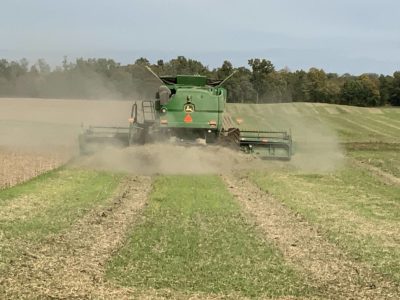 My family is well into soybean harvest, and so far yields have been above average. With about three-fourths of the soybeans in our storage bins, we are on track for what could be our second-best crop.
My family is well into soybean harvest, and so far yields have been above average. With about three-fourths of the soybeans in our storage bins, we are on track for what could be our second-best crop.
We started cutting soybeans the last week of September, as expected. Heavy rains in our area of the U.S. northeast have kept us out of the field for up to a week at a time. Even with the weather, we are ahead of our average pace for soybean harvest.
The soybeans matured really fast this year. However, some fields and varieties have had higher moisture content than others. We’ve harvested soybeans with more than 17% moisture, while others have been just 14% or 15% moisture. We target 13% moisture as ideal for storage.
The soybeans are ready to cut, and we’ve had plenty of wet weather, so we aren’t waiting for them to dry out in the field. In the past, we have run our soybeans through our drying system to reach the ideal moisture level. This year we are just storing the soybeans in two large grain bins. We are putting drier soybeans in one bin and wetter soybeans in the other. Large fans in the storage bins blow air that will help dry out the soybeans, while using less fuel than our drying system.
 I handle unloading the soybeans from the field into these storage bins. I drive our trucks from each field to our grain storage location. That’s my harvest job, though I often mow waterways and ditches to help us keep fields tidy and keep weeds and trees from growing while I wait for the truck to be filled. My younger son Ben drives the combine, while my wife Shirley drives the grain cart that carries the crop from the combine to the truck I’m driving at the edge of the field. My older son Rodman spreads fertilizer or strip-tills harvested fields to begin preparing them for next season.
I handle unloading the soybeans from the field into these storage bins. I drive our trucks from each field to our grain storage location. That’s my harvest job, though I often mow waterways and ditches to help us keep fields tidy and keep weeds and trees from growing while I wait for the truck to be filled. My younger son Ben drives the combine, while my wife Shirley drives the grain cart that carries the crop from the combine to the truck I’m driving at the edge of the field. My older son Rodman spreads fertilizer or strip-tills harvested fields to begin preparing them for next season.
The cover crops planted in our fields are growing well. In fact, we need to get our soybeans harvested quickly, so that the wheat cover crop doesn’t grow so tall that it stains the soybeans as we cut them. One challenge we’ve had during harvest is making sure the chaff from the harvested crop is spread evenly into the growing cover crops. Spreaders on the back of our combine help distribute soybean stems and pods behind the combine, but these attachments have had a tendency to come loose. Ben has to watch behind the combine as he goes through the field to make sure these spreaders are working — and stay on the machine.
 Once we finish soybean harvest, we will turn our attention to our corn crop. Right now, the corn kernels contain high moisture, and we expect it to dry out in the field for a couple weeks. Based on what we can see, we expect corn yields to be above average, but we are concerned that we may have low test weights, meaning that the corn could be less dense than preferred. That has been an issue in our area, even though we had a pretty good growing season.
Once we finish soybean harvest, we will turn our attention to our corn crop. Right now, the corn kernels contain high moisture, and we expect it to dry out in the field for a couple weeks. Based on what we can see, we expect corn yields to be above average, but we are concerned that we may have low test weights, meaning that the corn could be less dense than preferred. That has been an issue in our area, even though we had a pretty good growing season.
Right now, our focus is on balancing harvest progress and field preparation for next year in wet fields without making ruts so deep that we will have to till them next spring. I think we’ve been successful so far, and we hope to maintain that balance through the rest of the fall.
This field update is funded by the soybean checkoff. To share or republish part or all of this Ground Work 2021 article, please link to the original article and credit www.USSOY.org.






